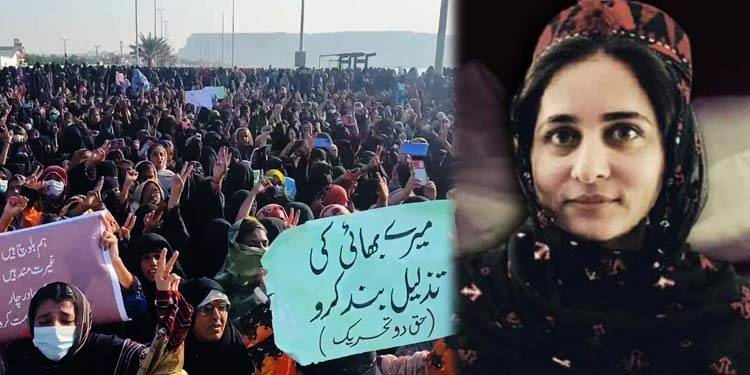
Two years have passed since the martyrdom of Karima Baloch, but Karima has settled in the hearts of Baloch nation in such a way that in her life she was given the title of "Rahshon," which means leader, but now she is being remembered with the title of "Lamah-e-Watan," or Mother-e-Watan.
In such a situation, the question must arise: What were the reasons that the government wanted to bury Karima quietly? Did those institutions and mentalities succeed in their goals after taking Karima's dead body from the Karachi airport and burying it under the strictest security? It is possible that still on December 21, on her anniversary, her native area and graveyard will be cordoned off and the common man will not be allowed to go there, but will Karima's struggle be anonymous, and will Karima be removed from the hearts of the nation? will If Karima's loved ones were allowed to come during her funeral prayer, would this congregation be bigger than the congregation of the religious group leader in Pakistan?
After these questions, the question remains: can the new generation of Baloch forget Karima? Karima was a Baloch girl. She was a Baloch student leader who was fighting against the distorted system of Sardari in Balochistan, but after her, how is the Baloch woman today in Makran and Balochistan?
Perhaps sitting in Lahore and Islamabad, one can console himself that Karima is no more, but in Balochistan, many Karimas have been born in every house. If you don't believe me, see the pictures of the recent public movement in Gwadar. Of course, this did not happen suddenly. These are the ideological followers of Karima who are now present in every nook and cranny of Balochistan and are part of the political arena in Baloch society because they too have to become Karima.
These are the fruits of the struggle that Karima had in her life for this change, as well as the results of the power that was adopted during the last rites of Karima Baloch, when a dead body was taken by force and buried in the shadow of fear.
On the day Karima's dead body was being taken from Karachi Airport to her native area Tump, there was a curfew. Mobile networks were shut down. But even in the shadow of this fear, the environment was like that which has been described in this article written back then:
*
"Deserted streets, strict vigils, waiting eyes, and a hatred above all of them." This hatred is different from general hatred because usually hatred is against oppression, cruelty, and brutality, but this hatred is against the fear that lurks in its shadow. This system is taking its last breaths, day by day.
While waiting for the caravan of Shaheed Karima, from Gwadar Zero Point to Kulach, Dasht, and D Baloch, many people stood with fear and hatred, but many times more fear was seen in the government machinery, which teared its eyes and looked at its past. They were spreading the system of oppression and fear of their mindset for seventy years, and perhaps they were also giving bad words in their hearts to those mastermind; due to their plans, today they also kidnapped a dead body. They were having to hide from herdsmen, students, women, and children, seeing the fear of their power defeated in the form of children and youth. Because even in the shadow of this fear, those who had the opportunity from a distance would have been present to give greetings. It seemed as if the media of Lahore and the houses of Islamabad were so threatened by this one body that they were hiding it, considering it more important than their atomic bomb.
When some vehicles in the convoy were forcibly stopped and returned, a common security official said: You know that the girl commander of the outlawed separatist organisation has been killed; the situation is very bad, so no one is allowed to go there.
I don't know what the officer was thinking when he gave this order, but because of the many people who were in the same position before him, it had a very bad effect on his blood pressure and psychology, which imposed a strict curfew and cut off all means of communication were closed.
Earlier, Karima Baloch was just a student leader for the common Baloch student who was a symbol of resistance to the patriarchal, conservative Baloch society, opportunist chieftains, and a few other parliamentary businessmen, but for the master minds if Islamabad, she was a symbol of resistance. Her death showed that even her body is a symbol of fear.
Children, women, and passers-by sit under the open sky in the bitter cold until late at night, waiting for the roads in D Baloch Chowk Turbat to open so they can return home. A few of their generation can hardly sit in a car with black glasses and be called patriots for a few bucks and protocol, but these uneducated mothers, children, and old people return to their homes after the opening of curfew. They will not forget the death of Karima and the oppression of the system.
Now more than ever, these people have started hating their inner fears. which the salaryman of a few pennies may be able to maintain until his job, but he will destroy his generations with this temporary plan.Because when that common official returns home tomorrow or their children tell them that this was done when a Baloch girl was dead,
*
Two years have passed since this piece of writing above, and in today's history we have seen Baloch women, instead of being afraid, silent, they are more brave, fighting and organising resistance. When thousands of women's rallies took place in Gwadar, it seemed as if thousands of Karima came out after one Karima.

